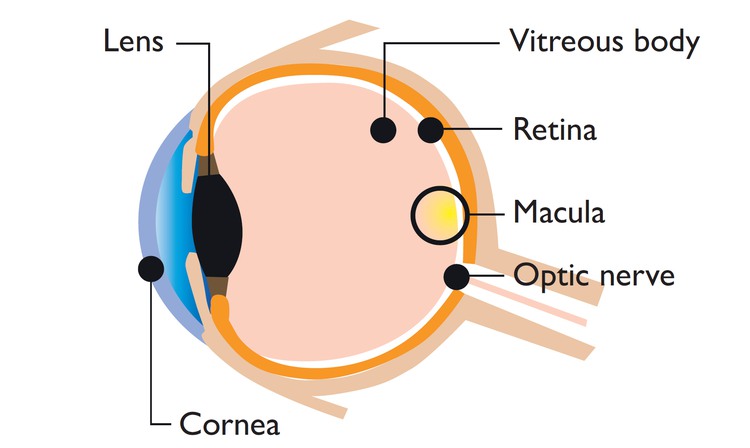Wet macular degeneration is a chronic eye disorder. It causes deterioration of visual cells, bleeding and swelling of the retina and it is the most common cause of visual impairment in the elderly.
It usually affects an area in the retina called the macula. Symptoms usually appear around 75–80 years of age. The injections in the eye not only halts the progression of the illness, they can also lead to significantly improved eyesight.
In certain patients, the illness goes into a slower phase and the injections can then be administered less frequently. Up until recently, it was considered unnecessary to continue the follow-up of these patients. At the same time, it has been known that it does not work for everyone, as many return to seek care after some time.
At St. Erik Eye Hospital, David Epstein led a study to find out how many patients had their vision problems return after a period with slower progress of illness. He guessed that it would be a maximum of 25 per cent.
It turned out that 60 percent got the disease back within a year. This was an eye-opener, says David Epstein, Senior Consultant at St. Erik Eye Hospital and researcher at Karolinska Institutet.
This study in particular is brand new and not yet published, but David Epstein and his colleagues have already changed the treatment programme.
Even if the eye looks good, you have to continue with the patient follow-up. Most likely, the patients were having symptoms, but did not seek care, he says.

Today there's a treatment for blood clotting in the eye.
Photo: Istock
Small measures increase quality of life
David Epstein never ceases to be amazed by how we are able, with fairly small means, to increase the quality of life for patients with diseases affecting the retina. It is also the reason why he began his research twelve years ago.
We believe we know so much, but it’s good to conduct proper studies, says David Epstein.
He has also conducted several studies on blood clotting in the eye, known as central retinal vein occlusion (CRVO). The blood clot forms as the circulation decreases in the retina, which then starts to swell from fluids and blood. This in turn can cause a grave visual impairment. Here too, the macula is affected.
The fact that we can treat the blood clots in the retina may be evident today. But twelve years ago, there was no registered treatment, he says.
As a matter of fact, you only need to rewind the tape back to the early 2000s to return to a time where patients with diagnoses relating to the macula were sent home untreated.
Agent against colon cancer improved eyesight
Around 15 years ago, a coincidental discovery was made that patients being treated for colon cancer, who had comorbidity involving the macula, would get slightly better eyesight.
American physicians guessed that some of the drug had found its way into the eye and therefore tried injecting a little more of this VEGF inhibitor straight into the eye. It proved effective. But these studies had no control group, which is considered highly important in research contexts.
Around this time, David Epstein, who had been working overseas for many years, was asked by some established researchers if he would like to help conduct a randomised double-blind study* on the drug. This time, the method of eye injections would be compared to giving no treatment at all.
They needed labour, a cheap underling, and that was me. So I met with all the patients and compiled all the results. For me it was a lot of fun.
The study proving that the injections could halt the progress of illness has been highly beneficial to patients of course.
I like that we are able to use very small means to increase our patients’ quality of life. One day, they can barely see, and the next day their eyesight has returned, says David Epstein.
Since then, CRVO has become something of a speciality for David Epstein and he has continued his research alongside clinical work as an ophthalmologist.
I still enjoy compiling data and putting numbers into the software to see the result emerge, he says.

Retina. The light-sensitive nerve layer that lines the inside of the back of the eye.
Illustration: Fidelity
Creatively combining clinic and research
Combining research with daily work in the eye clinic makes his work more creative.
For me, it usually starts with an idea or hunch that one treatment is more effective than another. You can often be surprised at how large the difference actually is between the treatments – and sometimes you are surprised instead at how small the difference is, he says.
These are important facts, since it can be a matter of cost and the patients’ quality of life. For a patient in treatment, it may for example be nice to have injections as rarely as possible.
In one study, David Epstein compared two different treatments for blood clots in the eye.
One of the drugs lasted 3.5 weeks longer than the other. That’s a lot fewer injections per year, he says.
David Epstein’s ambition is to improve life for his patient group and keep working much like today.
I want to keep making a difference and conducting studies where I monitor my patients.
Text: Maja Lundbäck
*A randomised double-blind study is one where participants are randomly assigned to different treatment groups: the group that receives the treatment to be studied and a control group.